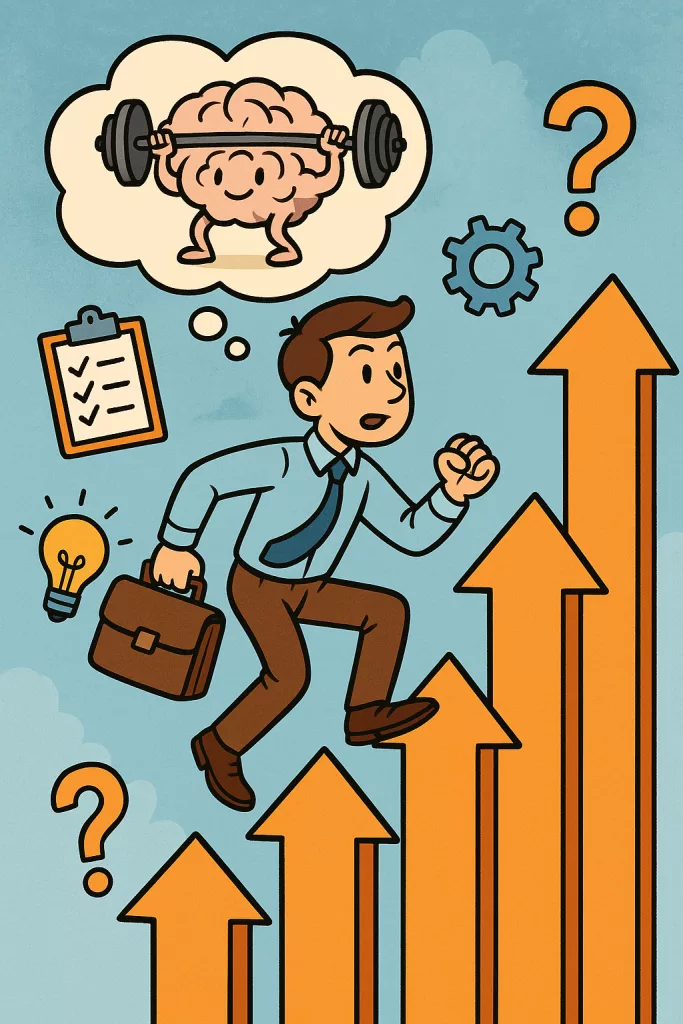Let’s face it: the business world is doing backflips every minute—AI tools popping up, traditional roles melting, and remote‑hybrid chaos becoming the new normal. In this circus, mental agility for career success isn’t a luxury—it’s your secret superpower. We’re talking serious flexibility, savvy adaptability, and the ability to pivot faster than your phone updates. From learning agility to “stagility” balancing, this is your guide to staying not just afloat—but thriving.

Why Mental Agility Actually Matters Today
1. The AI-Tech Tsunami Demands It
AI isn’t just here; it’s demanding high‑flex skills. By 2030, a massive 70% of job skills are expected to shift—and half the workforce could need reskilling today. That’s not sci‑fi jargon—it’s reality.
Machine learning is now automating complex decision-making that was once exclusively human territory—from legal research to medical diagnostics. This creates a paradox: as machines handle structured work, human value lies in navigating ambiguity and adapting to novel situations.
The professionals who thrive won’t compete with machines on their terms. Instead, they’ll dance with uncertainty, pivot when algorithms can’t, and bridge human insight with technological capability. New roles like AI prompt engineers and algorithmic bias auditors didn’t exist five years ago—mental agility has become the fundamental currency of career resilience.
2. Learning Agility Is the Real Game-Changer
“Learning agility” is the ability to process new info, connect dots, and adapt when things go sideways. Korn Ferry and others are saying it’s a cornerstone of leadership and career growth now.
But true learning agility goes deeper than quick knowledge absorption. Research from Harvard Business School shows high-learning-agile individuals are five times more likely to be rated as high-potential leaders. They don’t just learn—they actively seek evidence that challenges their assumptions and build new mental models when old ones fail.
These individuals treat failure as data rather than defeat, extracting actionable insights from setbacks. The neuroscience backs this up: adult brains remain remarkably adaptable, but require intentional cultivation through perspective-taking and cognitive flexibility exercises that literally rewire neural pathways.
3. The Rise of “Stagility”—Balancing Fast and Firm
Remember “stagility”? It’s that hybrid buzzword coined in 2025 by Deloitte: marrying agility with the stability workers crave in an ever‑evolving landscape. When you embody mental agility, you’re not just riding waves—you’re shaping the tide.
Stagility tackles a fundamental workplace tension: employees need stability to feel secure, yet organizations must remain agile to survive volatile markets. This isn’t about finding middle ground—it’s about achieving both through strategic mental flexibility.
Mentally agile professionals develop “dynamic stability”—core principles that remain constant while methods evolve rapidly. They become reliable constants their teams depend on, not because they never change, but because they change intelligently. Instead of being paralyzed by uncertainty, they build transferable capabilities and robust decision-making frameworks that work across multiple scenarios.
Emerging Trends Where It’s Paying Off Big Time
1. AI + Mental Agility = The Dynamic Duo
With AI doing the routine, humans need sharp mental agility to focus on creativity, critical thinking, and innovation. Deloitte’s data shows that reskilling in AI and boosting soft skills nearly doubles employee engagement and financial performance.
2. Leaders Value Curiosity and Agility
Leading employers (like those on Korn Ferry’s most‑admired list) are seeking “learning agility” and curiosity more than anything else these days.
3. Skill Agility Fuels Professional Resilience
In 2025, “learning and skill agility”—the ability to learn quickly and flexibly—is pushing individuals and companies through uncertain environments.
Practical Growth Tips: Building Mental Agility for Career Success
Here’s the good stuff: real, down‑to‑earth ways to train your brain to flex better than a yogi.
1. Learn Agile, Live Agile
- Try things outside your comfort zone—projects, new software, brainstorming, even improv.
- Use tools like logic puzzles or even coding challenges to stay in “quick‑think” mode.
2. Pause, Reflect, Evolve
That stressful meeting? Sit with it. Ask:
- “What did I learn?”
- “How might this influence my next move?”
3. Loop in Feedback
Don’t be shy—ask your mentor or peer how you responded to turbulence. See blind spots. Grow.
4. Use AI as a Bouncer, Not a Boss
- Get hands‑on: experiment with AI tools. You’ll figure what works—and what pumps you.
- Remember: the tech’s there to serve you, not replace you.
5. Drop Old Anchors; Create New Ones
Deloitte calls for new stabilization anchors: flexible structures, reimagined roles, and stronger human networks. Align your career with those foundations.
Example: Meet Jane—The “Mental Agility” MVP
She was stuck: same role, same routine, AI creeping in. But she:
- Took a weekend online class in prompt engineering.
- Volunteered to streamline her team’s workflows using AI.
- Asked for project feedback and iterated quickly.
Within months? Her team’s productivity surged, she got noticed, and her role evolved into AI-integration lead. That’s mental agility for career success in action.
Wrapping It Up: Your Take-Home Blueprint
Mental agility for career success isn’t fluff. It’s the muscle that lets you:
- Surf AI and change waves instead of getting knocked into the sand.
- Learn on the fly, pivot with confidence, and apply what matters.
- Stand firm when needed, and sprint forward when the moment begs.
Quick Checklist
- Embrace discomfort—learn new tools, take new tasks.
- Reflect on how you respond to stress and change.
- Align with organizations that value agility and provide stability.
- Keep curiosity and adaptability at the heart of how you grow.
The world’s moving at lightspeed—so let your mind move faster, with both grace and grit.
References
- Holtzlander, A. (2025). What Is Learning Agility, and Why Do We Need It? MentorcliQ, March 27, 2025. Retrieved from MentorcliQ website https://www.mentorcliq.com/blog/
- Dai, G. R., De Meuse, K. P., & Tang, K. Y. (2013). The Role of Learning Agility in Executive Career Success: The Results of Two Field Studies. Journal of Managerial Issues, Vol. XXV, No. 2, Summer 2013. Retrieved via ResearchGate. ResearchGate
- MentorcliQ (2024). The Power of Mental Agility in Dealing with Organizational Change. Enterprise Agility Magazine, July 1, 2024. https://magazine.eau.university






